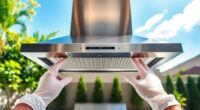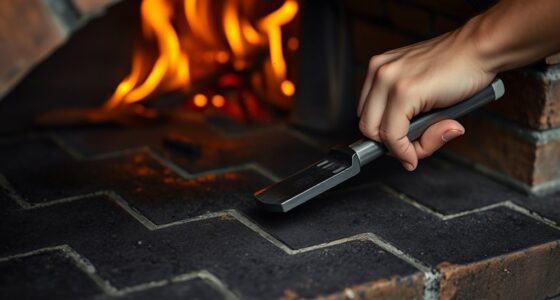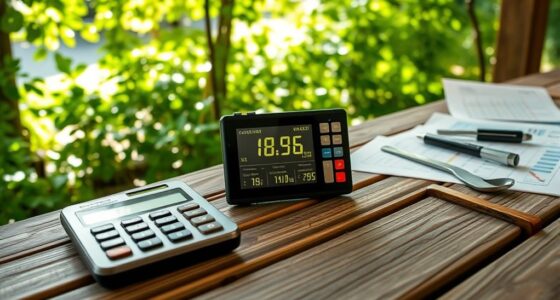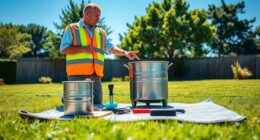To prevent rust outdoors, keep your metal items dry by storing them in covered, ventilated spaces and regularly drying surfaces. Clean off dirt and debris, then apply protective coatings like rust-resistant paint, sprays, or natural oils like mineral or linseed oil. Proper storage and routine inspections also help catch rust early. If you follow these simple steps, you’ll considerably extend your metal’s life—and there’s more to discover that can help you stay ahead of rust.
Key Takeaways
- Keep metal dry by storing in covered, well-ventilated areas and avoiding contact with soil or water.
- Regularly clean and dry metal surfaces to remove dirt and moisture that cause rust.
- Apply protective coatings like rust-resistant paint, galvanization, or natural oils to create a barrier against moisture.
- Use natural remedies such as vinegar, lemon juice, or mineral oil to prevent or slow rust formation.
- Inspect and reapply protective coatings periodically, especially during off-seasons, for ongoing rust prevention.
Understanding Why Metal Rusts Outdoors
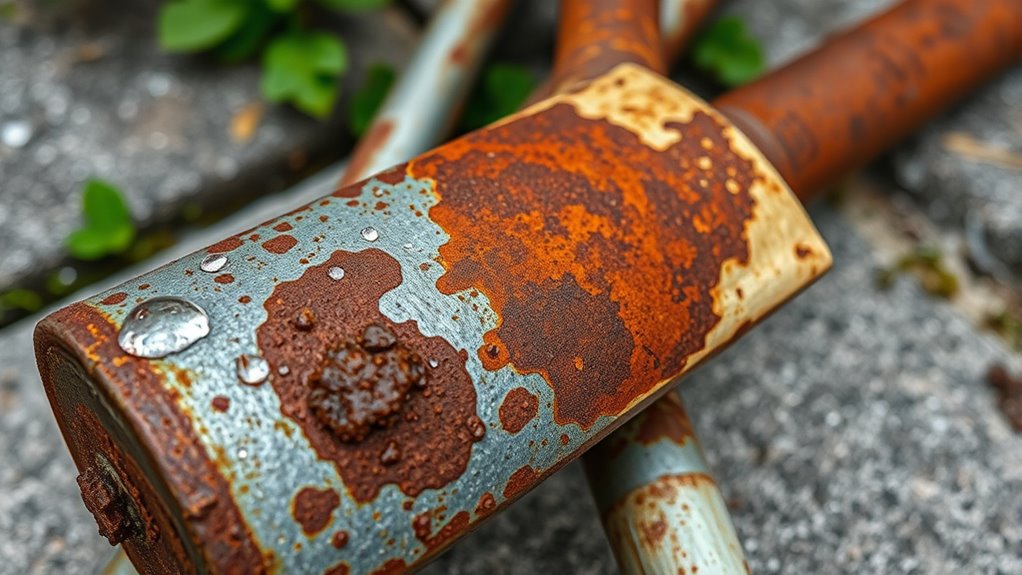
Metal rusts outdoors primarily because it reacts with moisture and oxygen in the environment. Your metal’s composition plays a big role in how quickly this happens. For example, iron is especially prone to rust because it easily reacts with water and oxygen, forming rust quickly. Other metals like stainless steel or aluminum contain elements that help resist corrosion, but they aren’t completely immune. Environmental factors also influence rusting; high humidity, rain, and exposure to salty air accelerate the process. Temperature fluctuations cause metal to expand and contract, creating tiny cracks that let moisture seep in. Understanding the corrosion process helps you understand why rust forms and guides you in taking better preventative measures.
The Importance of Keeping Metal Dry
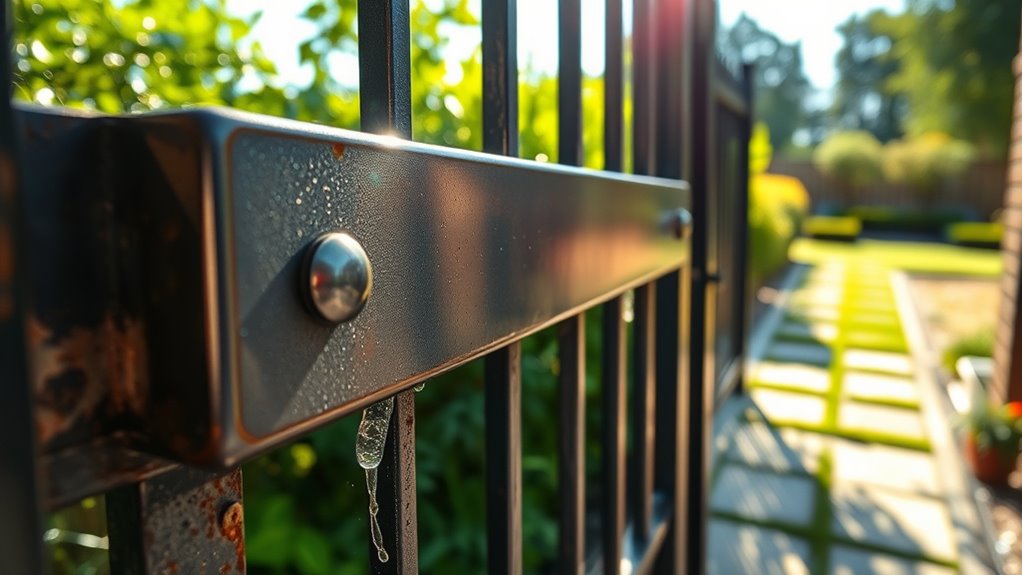
Keeping metal dry is essential because moisture is the primary catalyst for rust formation. When metal stays wet or damp, it encourages metal corrosion, which weakens the structure and shortens its lifespan. Effective moisture control prevents rust from developing, saving you time and money in repairs. To keep metal surfaces dry, wipe off water after rain or dew, store items in covered areas, and use protective coatings like paint or sealants. Good airflow also helps evaporate moisture quickly. The less moisture that contacts the metal, the less likely rust will form. Staying vigilant about moisture control is your best defense against rust damage outdoors. Additionally, choosing rust-resistant materials for outdoor metal items can further enhance their durability. By keeping metal dry, you prolong its durability and ensure it remains strong and functional for years to come.
How to Clear Dirt and Debris From Metal Surfaces
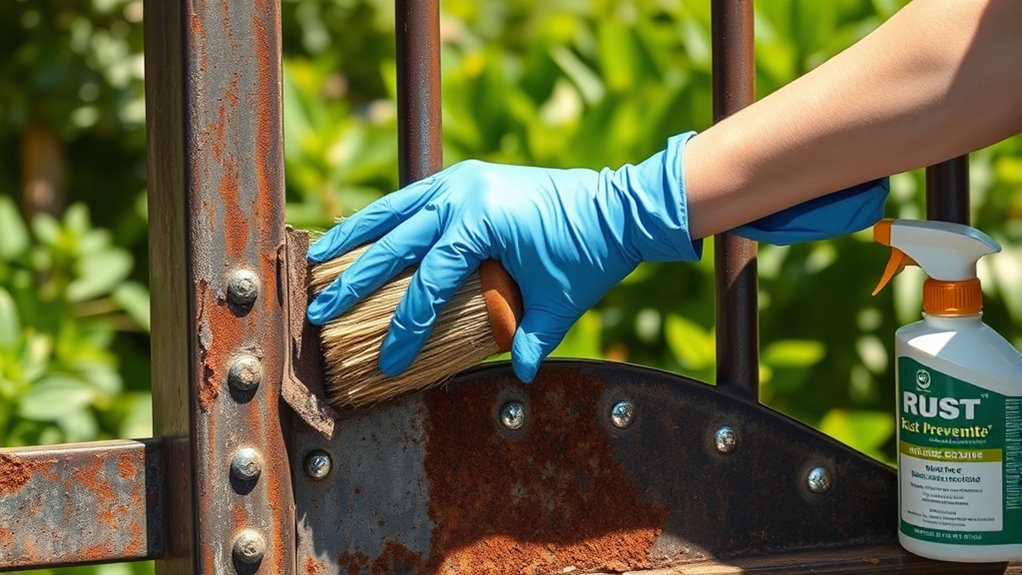
Dirt and debris can quickly accumulate on metal surfaces, compromising their appearance and potentially leading to corrosion if left unchecked. To keep your metal looking its best and prevent rust, you need effective dirt removal. Start by rinsing the surface with water to loosen loose dirt. Then, follow these steps:
Regular cleaning prevents rust and keeps metal surfaces looking their best.
- Use a soft brush or cloth to gently scrub away dirt and debris, avoiding scratches.
- Apply a mild soap or specialized metal cleaner for stubborn grime, ensuring metal polishing for a smooth finish.
- Rinse thoroughly with clean water and dry completely to prevent water spots and future dirt buildup.
- Regular cleaning and maintenance can significantly extend the lifespan of your metal surfaces and prevent rust formation.
Regular cleaning keeps your metal surfaces clear of debris, helping to maintain their integrity and appearance over time.
Applying Simple Protective Coatings
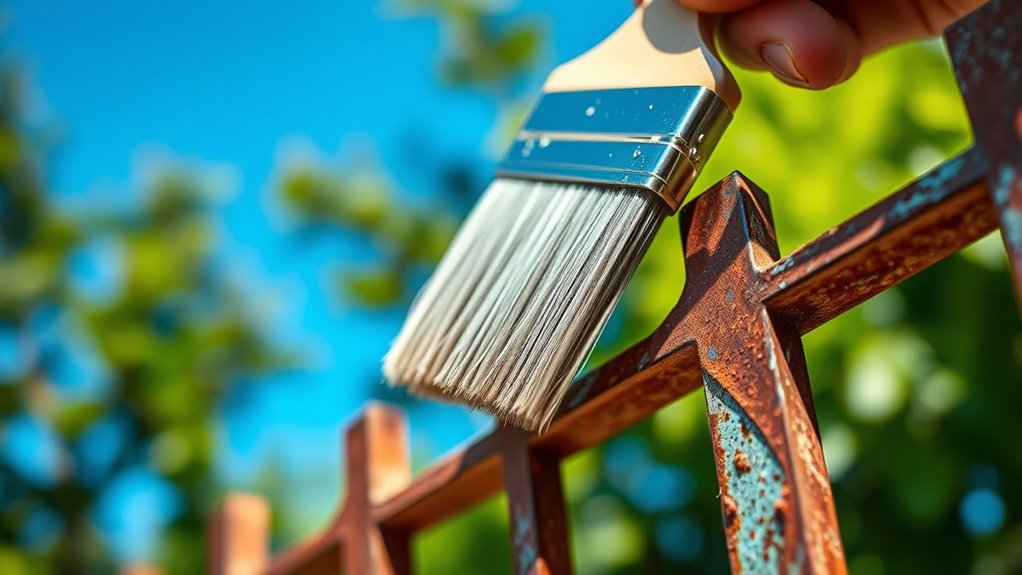
Applying simple protective coatings is an effective way to shield your outdoor metal surfaces from moisture and environmental damage. Metal galvanization involves coating steel or iron with a layer of zinc, providing long-lasting rust protection. Additionally, using rust inhibitors creates a barrier that prevents moisture from reaching the metal. You can apply these coatings with brushes, rollers, or spray systems, ensuring even coverage. Make sure the surface is clean and dry before applying, as dirt and rust can compromise adhesion. Reapplying protective coatings periodically enhances durability and keeps rust at bay. These simple steps considerably extend the life of your outdoor metal items without complicated procedures or expensive treatments. Regular application of protective coatings keeps your metal surfaces looking good and rust-free for years. Incorporating professional-grade products can further improve the effectiveness of your rust prevention efforts.
Using Rust-Resistant Paints and Sprays
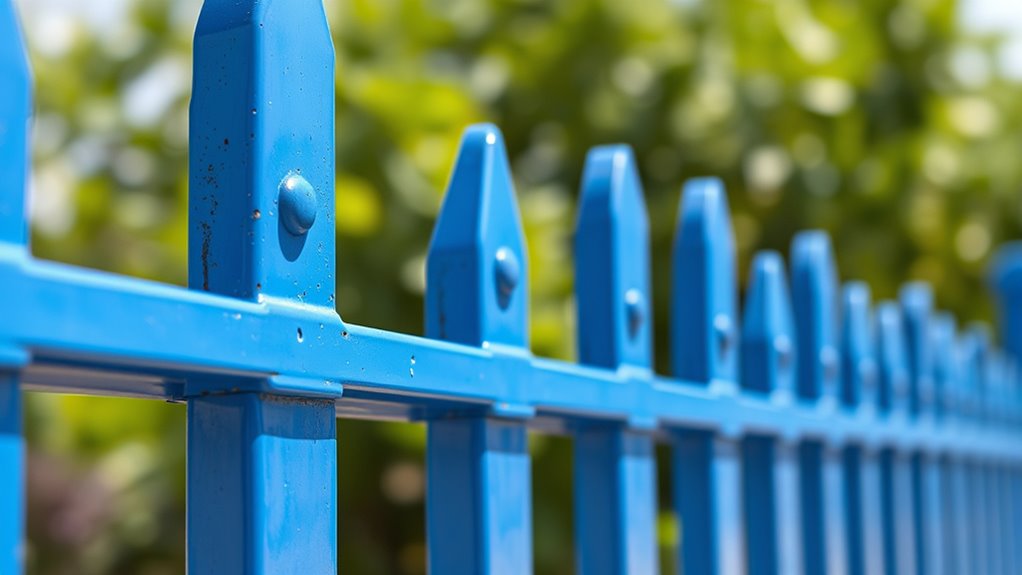
After applying protective coatings, choosing the right paint or spray can further enhance your metal surfaces’ resistance to rust. Rust-resistant paints contain rust inhibitors that prevent corrosion, while sprays improve metal bonding for durability. To maximize effectiveness, consider these tips:
- Select a paint with rust inhibitors to create a chemical barrier against moisture.
- Use sprays designed for outdoor metal surfaces, ensuring strong metal bonding.
- Apply multiple thin coats for even coverage and better protection.
- Regular inspections help identify early signs of wear and corrosion, ensuring ongoing rust prevention.
Regular Maintenance Checks and Touch-Ups
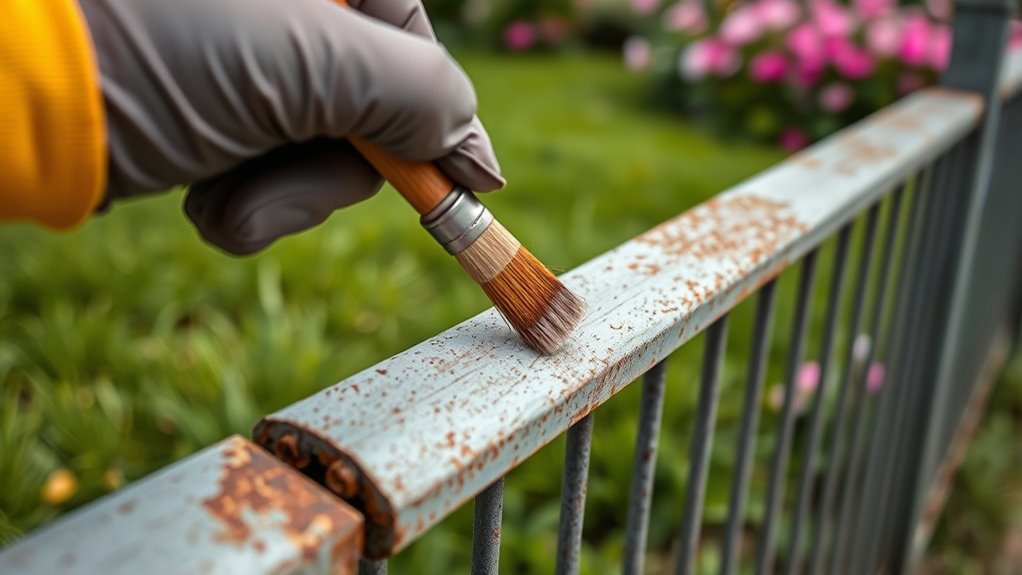
You should establish a regular inspection routine to catch rust early before it spreads. When you notice small spots, address them quickly with touch-up repairs to prevent further damage. Consistent checks and prompt actions keep your outdoor surfaces looking good and rust-free. Incorporating preventive measures like applying protective coatings can further reduce rust formation over time.
Scheduled Inspection Routine
Regular maintenance checks are essential to catching rust early before it causes significant damage. A scheduled inspection routine helps make certain your outdoor metal fabrication maintains its corrosion resistance and structural integrity. During inspections, you should:
- Examine all surfaces for signs of rust or corrosion, paying close attention to joints and seams.
- Clean off dirt, debris, and moisture that can accelerate rust formation.
- Touch up any chipped or worn protective coatings with rust-inhibiting paint or sealants.
Spot Rust Early
How can spotting rust early save your outdoor metal projects from costly repairs? The key is catching rust formation before it worsens. When you notice the first signs of rust, you prevent metal oxidation from spreading and causing deeper damage. Regular maintenance checks help you detect rust spots early, especially in hidden or hard-to-see areas. Touching up small rust patches with rust-resistant paint or sealant stops oxidation in its tracks. By acting promptly, you keep your metal surfaces protected and extend their lifespan. Ignoring early rust signs can lead to structural weakening and expensive replacements. Staying vigilant with routine inspections and quick touch-ups ensures your outdoor metal projects remain durable and rust-free for years to come. Incorporating preventive measures like protective coatings can further reduce the chances of rust development.
Quick Repair Actions
Performing routine maintenance checks and quick touch-ups is essential for keeping outdoor metal projects in top condition. Regular inspections help you catch early signs of rust and address them quickly. To maintain metal galvanization and prevent rust, consider these actions:
- Clean and assess the surface, removing dirt and debris that can trap moisture.
- Apply rust inhibitors or touch-up paint to exposed areas, especially on vulnerable spots.
- Reapply a protective coating or sealant to reinforce metal galvanization and prevent future rust formation.
Storing Metal Items Properly During Off-Seasons
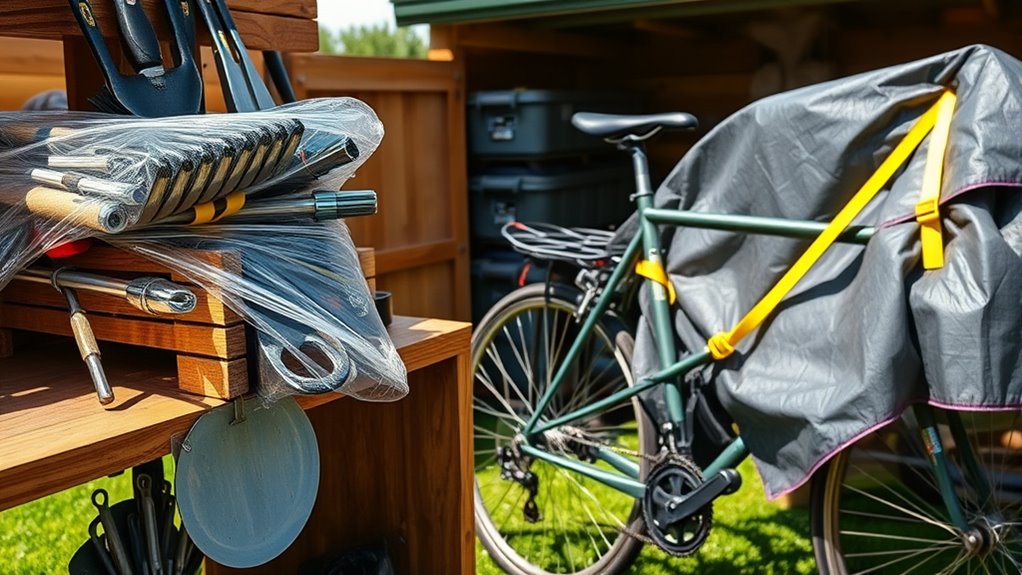
Before storing metal items for the off-season, make sure to clean them thoroughly to remove dirt and moisture. Applying a protective coating can help prevent rust, and selecting a dry, well-ventilated space is key. Proper storage habits keep your metal tools and equipment in top shape for when you need them again. Using rust prevention techniques during storage can further extend the lifespan of your metal items.
Clean Before Storage
To effectively prevent rust, you need to start by thoroughly cleaning your metal items before storing them for the off-season. Proper cleaning removes dirt, moisture, and corrosive substances that can lead to rust. Begin with these steps:
- Use metal polishing tools to buff surfaces and restore shine, which also helps with rust removal.
- Apply a rust remover to any spots showing early signs of corrosion, ensuring they don’t spread.
- Wipe down items with a clean, dry cloth to eliminate residual moisture, reducing the risk of rust forming during storage.
- Ensuring proper color accuracy and contrast ratio during cleaning can also help identify areas needing extra attention, preventing hidden corrosion.
Taking these steps before storage ensures your metal items stay protected and look their best when you need them again. Cleanliness is vital to rust prevention.
Use Protective Coatings
Applying protective coatings is a key step in keeping your metal items rust-free during storage. Metal plating provides a durable barrier that prevents moisture from reaching the metal surface, reducing rust risk. You can also use anti corrosion sprays, which create a thin, protective film that shields against humidity and environmental elements. Before applying these coatings, guarantee your items are clean and dry. Metal plating is especially effective for tools and outdoor equipment, while anti corrosion sprays work well for smaller parts or intricate designs. Regularly reapply these coatings during off-seasons to maintain protection. Using these protective measures helps extend the lifespan of your metal items and keeps them looking and functioning like new. Incorporating farmhouse-style decor or storage solutions can also help organize your outdoor tools and keep them protected from the elements.
Choose Proper Storage Space
Choosing the right storage space is essential for protecting your metal items during the off-season. Proper storage prevents rust and damage, especially outdoors. When selecting a space, consider these options:
- Use metal shelving inside a dry, well-ventilated shed or garage to keep items off the ground and prevent moisture buildup.
- Opt for covered outdoor storage units that shield your tools from rain and humidity.
- Ensure your outdoor storage area is elevated and away from direct contact with soil or water, reducing exposure to moisture.
Avoid storing metal items directly on the ground or in damp environments. Properly chosen storage, especially with metal shelving or covered outdoor storage, keeps rust at bay and extends the life of your tools and equipment.
Natural Remedies and Home Solutions for Rust Prevention
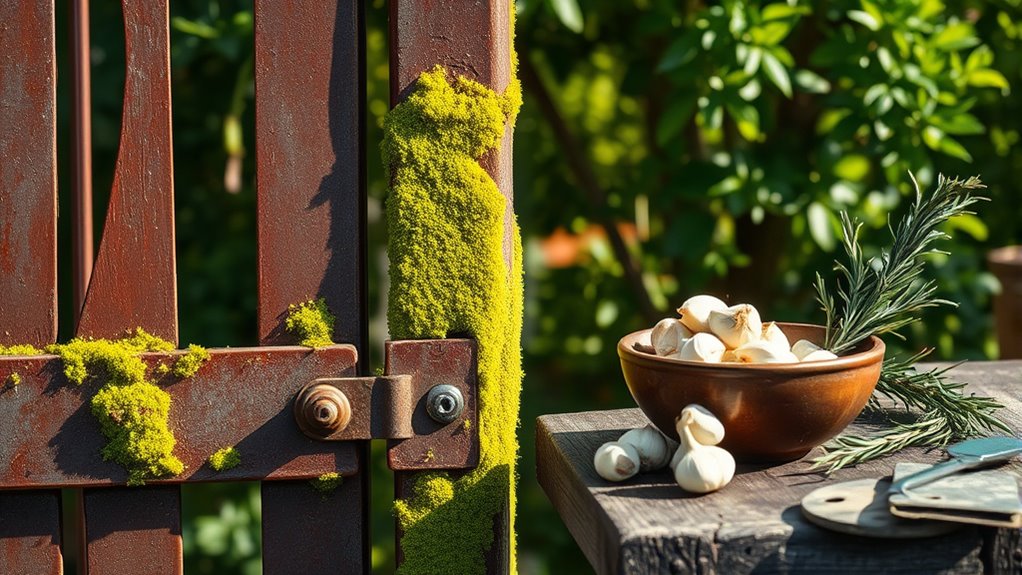
Natural remedies and home solutions offer effective ways to prevent rust outdoors without relying on harsh chemicals. One simple method is using natural rust inhibitors like vinegar or lemon juice, which can dissolve existing rust and create a protective barrier. Additionally, applying a homemade mixture of baking soda and water helps neutralize rust-forming acids. For long-term protection, consider using metal galvanization techniques or coating your tools and furniture with natural oils such as linseed or mineral oil. These oils seep into the metal, forming a barrier that slows oxidation. Regularly cleaning and drying your outdoor metal items also reduces moisture, preventing rust from forming. By combining these natural remedies with proper maintenance, you can extend the life of your outdoor metals without harmful chemicals.
Frequently Asked Questions
Can Rust Be Completely Removed Once It Starts?
Rust can be removed, but it’s rarely completely gone, especially if it’s deeply ingrained. You should use rust removal methods like sanding, chemical rust removers, or wire brushing to clean the surface. Afterward, apply rust prevention methods like paint, sealants, or rust inhibitors to stop it from returning. Regular maintenance helps keep rust at bay, but some damage might be permanent if rust has penetrated deeply.
Are There Environmentally Friendly Rust Prevention Options?
Think of protecting your belongings like nurturing a delicate garden—you want eco-friendly solutions that won’t harm the earth. Yes, there are natural remedies and environmentally friendly rust prevention options. These include applying plant-based oils, beeswax, or commercial eco-friendly rust inhibitors. They act like a gentle shield, keeping rust at bay while respecting nature’s delicate balance. Embrace these green choices to preserve your outdoor treasures with care and consciousness.
How Long Do Protective Coatings Typically Last Outdoors?
Protective coatings usually last between 2 to 10 years outdoors, depending on the type and application. You can reduce metal deterioration and extend coating longevity by choosing high-quality, weather-resistant products and reapplying them as needed. Regular maintenance helps make certain your metal surfaces stay protected from rust, especially in harsh environments. Keep an eye on the coating’s condition, and touch up or recoat when signs of wear appear to maximize protection.
What Are the Best Ways to Prevent Rust on Outdoor Tools?
Think of your tools as brave warriors. To keep them strong, treat their armor—metal—with rust-resistant coatings and apply protective metal treatment regularly. Store them in dry, covered storage solutions like tool sheds or cabinets to shield them from rain and humidity. Wipe tools after use, and consider applying oil or rust inhibitors. These steps create a fortress around your tools, preventing rust and extending their battle-ready life outdoors.
Does Regular Cleaning Help Prevent Rust Formation?
Yes, regular cleaning helps prevent rust formation. When you clean your tools, you remove dirt, moisture, and debris that can cause rust. Use rust inhibitors during surface preparation to protect the metal. After cleaning, dry all surfaces thoroughly to prevent moisture buildup. Applying a light coat of oil or rust inhibitor creates a protective barrier, reducing the chances of rust developing and extending the life of your outdoor tools.
Conclusion
If you ignore rust prevention, your metal items could turn into useless piles of scrap faster than you can blink! By keeping things dry, cleaning regularly, and applying protective coatings, you’re literally saving them from a fiery fate of decay. Don’t let rust win — take action today! With a little effort, you can keep your outdoor treasures shining bright for years to come. Protect them now, or say goodbye to their beauty forever!

